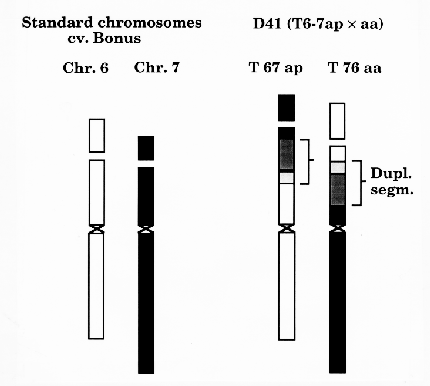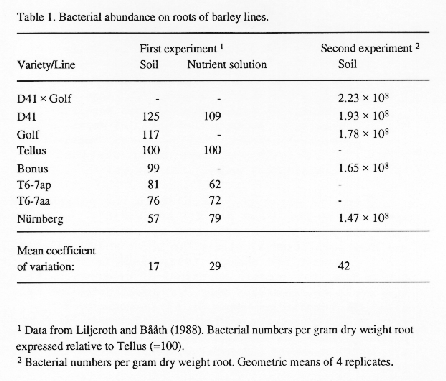

Growth of bacteria and other microorganisms in the rhizosphere of plants occurs in response to the input of organic compounds exuded by the roots. Microorganisms growing on plant roots can, through different mechanisms, be harmful or beneficial for plant growth and therefore it is important to understand different factors influencing microbial colonization of roots. Exudation and microbial growth are influenced by environmental factors. However, the quantity and quality of root exudates might be genetically determined since variation in microbial colonization has been found among varieties of different crop species (Bowen and Rovira, 1991).
We here report data on bacterial abundance related to a duplication in barley. Duplications are defined as modified genomes comprising duplicated chromosome segments which have been produced by intercrossing translocation lines characterized by rearrangement of identical chromosome segments in different ways (Hagberg and Hagberg, 1978, 1991). Among a series of duplications involving chromosome 6 and 7, D41 was selected for the experiments, because it is highly productive, well adapted and with increased grain yield compared to its parental translocation lines (Hagberg and Hagberg, 1987). Chromosome morphology alterations in D41 are shown in Figure 1. This particular duplication was obtained in the F2 generation of a cross between the translocations T6-7aa and T6-7ap. The two translocations were induced by ionizing irradiation treatment of the cultivars Bonus and Foma, respectively.
Li1jeroth and Bååth (1988) studied bacterial abundance on roots of barley varieties. Some of those data, including lines with chromosome structural rearrangements, were extracted and are shown in Table 1. In addition a second measurement was done and the results are shown in Table 1. In this second experiment a duplication line selected from the cross between D41 and the high yielding cultivar Golf was also included. The bacteria was counted microscopically after acridine orange staining on 10 days old barley seedling (Liljeroth and Bååth, 1988).
Liljeroth and Bååth (1988) found significant differences in the numbers of bacteria among barley varieties. The duplication line D41 had significantly higher numbers than its parental lines T6-7aa and T6-7ap (p<0.05). The influence of genotype was further indicated by a significant rank correlation between soil grown plants and nutrient solution grown plants. Thus, similar genotypical differences in bacterial abundance was found in different environments. The results in our second experiment here confirmed the earlier reported differences. Although the varieties did not differ significantly, they ranked similar to what was found by Liljeroth and Bååth (1988). Ile line from the cross D41 × Golf tended to have even higher numbers of bacteria on the roots than its parents. It is not known what impact higher or lower bacterial numbers have on plant growth since rhizosphere bacteria can be both harmful and beneficial. However, the results show that genetic changes in the plant can influence a character like rhizosphere microbial colonization, as is demonstrated by the lines with chromosomal structural rearrangements. This is interesting since future developments might give possibilities to create plants that favour root colonization by microorganisms which will for example increase yield potential by facilitating nutrient uptake or improve protection against pathogens.


References
Bowen, G.D. and Rovira, A.D. (1991) The rhizosphere, the hidden half of the hidden half. In "Plant Roots, the hidden half'. Edited by Y. Waisel, A. Eshel and U. Kafkafi. Marcel Dekker, Inc. New York. pp 641-629.
Li1jeroth, E. and Bååth, E. (1988) Bacteria and fungi on roots of different barley varieties (Hordeum vulgare L.). Biol. Fertil. Soils 7, 53-57.
Hagberg, A. and Hagberg, G. 1987. Some vigorous and productive duplications in barley. In: "Barley Genetics W, Proc. 5th Intern. Barley Genet. Symp., Okayama, 1986, p 423-426.
Hagberg, A. and Hagberg, P. 199 1. Production and analysis of chromosome duplications in barley. In: "Chromosome engineering in plants, Part A.", Eds.: S. Gupta and T. Tsuchiya. Publ. Elsevier, p. 401-410.
Hagberg, P. and Hagberg, A. 1978. Segmental interchanges in barley. 111. Translocations involving chromosomes 6 and 7 used in production of duplications. Z. Pflanzenzuchtung 81, 111-117.